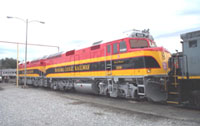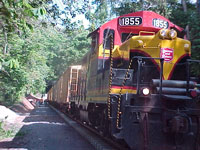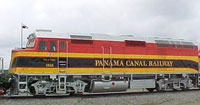 | Locomotives:
|
| |
 |
| F40
locomotives | a.Ten
F40 Locomotives acquired from Amtrak. These are rated at 3250hp and have ‘head-end’
power, which will allows PCRC to supply electricity not only to the passenger
coaches but also to reefer containers of the intermodal trains. PCRC operates
the ‘push-pull concept’ on the passenger coaches whereby a locomotive
is positioned at each end of the train, thereby eliminating the need for switching. |
 |
| GP10 |
b.One GP10 locomotive
used mainly on work trains | |
| |
 |
| 1858
locomotive side view | Each
locomotive has been named after a city or town along the railroad route and in
numerical sequence starting from 1855 – the year the railroad was originally
inaugurated
1855 – City of Colon
1856 – City of Panama
1857
– City of Gamboa
1858 – City of Gatun
1859 – City of Paraiso
1860
– City of Pedro Miguel
1861 – City of Coco Solo
1862 – City
of Corozal
1863 – City of Diablo
1864 – City of Balboa
1865
– City of Ancon |
| |
|
 | Passenger
coaches: |
| |
|
Five
luxuriously remodeled passenger coaches, each with a capacity of 50 passengers. |
| | |
| |
|
 | Dome
car: |
| |
One
completely refurbished 1938 Southern Pacific dome car, which seats 60 passengers. |
| |
Each coach has been named after a one of Panama’s rivers as follows:
| Rio Indio | Rio
Pequení | Lago
Gatún | Rio
Mamoní | | Rio
Bayano | Rio
Chagres | | | |
| |
|
 | Container
Handling/Lift Equipment / |
| |
| a.Two Mi-Jack 850P
rubber-tired gantry cranes with 90,000 lb lift capacity under spreader |
| b.Three
Fantuzzi/Mi-Jack Model 450 top loader with 80,000 lb lift capacity under spreader |
| c.One
Taylor top loader model 950 with 80,000 lb lift capacity under spreader |
| d.One
Komatsu top loader with 70,000 lb lift capacity under spreader. |
|
| |
|
 | Rail
cars |
| |
| a.Twenty
Two articulated 5-well double-stack bulkhead-type rail cars, originally built
by Gunderson. The cars have been reconditioned and repainted, and feature new
wheels, bearings and other key components. The cars have also been equipped with
multiple unit (MU) cables allowing locomotives to be cut-in or run the push-pull
method. | | b.Six
flat cars | | |
c.Ten
open top hopper cars | |
d.Reefer
connections | |
| |
|
 | Maintenance
of way/track equipment |
| |
| a.Tamper: Its a model
6700 manufactured by The Jackson Corporation and operates on the track. It is
capable of raising and lining up to two miles of track a day. It will be used
by PCRC to maintain the track in a smooth and straight condition for a smooth
and comfortable train ride. | |
b.Swingloader: It's a model SL180-13 manufactured by Swingmaster of Chicago. It has four rubber tires similar to an end loader and also has high rail wheels so that it can operate on the track as well as in the yard. It has a boom on the front for the handling of track materials such as rails and ties. The material can be handled by using hooks, clamps, or a magnet. | |
c.Ballast regulator:
It's a model KBR 900 manufactured by The Knox Kershaw Corporation and operates
on the track. Its main purpose is to shape the crushed stone ballast so that the
ballast is properly maintained around and between the concrete ties. It also has
a large rotary broom mounted on the rear to sweep the track and keep the ties
clean to facilitate track inspection. | |
d.Hy-rails: PCRC has
a fleet of hy-rail vehicles that include: | |
|
| • | One
2-ton service truck and one 3/4 ton service truck both with capabilities
to operate hydraulic powered tools for track maintenance and both with booms for
the handling of equipment and materials. | | • | Two
Suburbans with the capabilities to carry up to seven people for track inspections
and tours. | | • | One
3/4-ton pickup equipped with a rail greaser for greasing the rail in curves and
switches as well as other service operations. | | • | One
Dodge Durango used for track inspection. | |
| |
 |
|
| | |
 | Terminal
Equipment |
|
Twelve hostlers and ten trailers
used in terminal operations moving containers |
